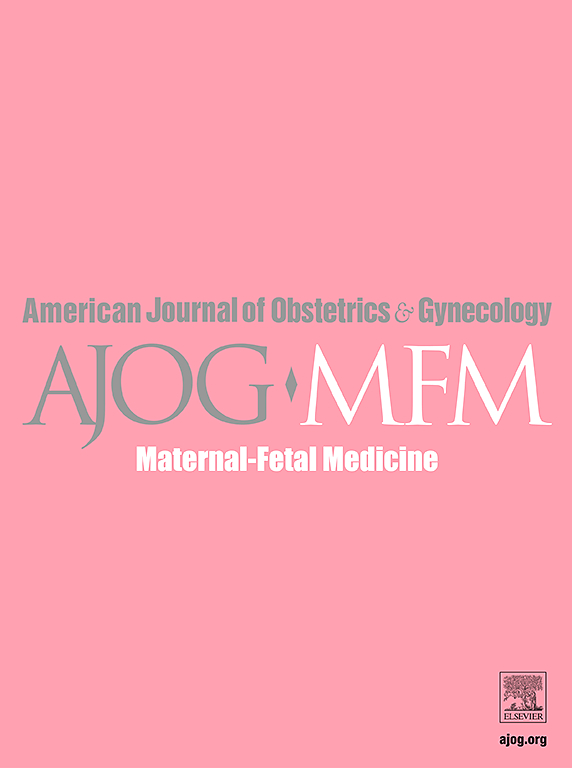The interplay between birth weight and intraventricular hemorrhage in very preterm neonates—a retrospective cohort study
IF 3.8
2区 医学
Q1 OBSTETRICS & GYNECOLOGY
American Journal of Obstetrics & Gynecology Mfm
Pub Date : 2025-02-04
DOI:10.1016/j.ajogmf.2025.101628
引用次数: 0
Abstract
Background
Intraventricular hemorrhage (IVH) most commonly occurs in infants born very preterm (<32 weeks’ gestation). There are mixed findings on whether infants small for gestational age (SGA) or with suspected fetal growth restriction (FGR) are at higher risk for IVH. Understanding the relationship between SGA or FGR and IVH is critical to inform clinical care.
Objective
The primary aim was to determine the rates of IVH in very preterm newborns, with SGA or suspected FGR, and to stratify for severity of both FGR and IVH. The secondary aim was to identify risk factors for IVH in a large contemporary cohort.
Study Design
A population-based retrospective cohort study using data from the Australian and New Zealand Neonatal Network. Participants were babies born before 32 weeks’ gestation (22–31 weeks + 6 days gestation) between 2014 and 2019 inclusive. The primary outcomes were IVH and severity of IVH. Small babies were classified as being SGA (SGA; birth weight <10th percentile), suspected FGR (birth weight <10th and ≥3rd birth weight percentile and abnormal antenatal ultrasound), or severe FGR (birth weight <3rd percentile). Multivariate regression was then performed, adjusting for potential maternal and fetal confounders to determine the association between FGR and IVH.
Results
20,551 very preterm newborns were included in the study with a median gestational age (25th, 75th) of 29 (27, 30) weeks gestation and birth weight of 1201 (383.9) grams. The incidence of any IVH was 20.02% (n=4115) and increased with decreasing gestation at birth (10% of infants born at 31 weeks had IVH compared with 70% of infants born at 22 weeks). The rate of severe IVH (Grade 3 or 4) was 3.23%. In this cohort, 7.7% were SGA (n=1583) and 6.23% (n=1281) of babies had suspected early-onset FGR. The incidence of SGA was reduced in babies with IVH (6.0% vs 8.1%, respectively, aOR, 0.82; 95% CI 0.68–0.97). Similarly, suspected FGR was significantly lower in infants with IVH (any grade) compared to those without (2.5% vs 4.6%, respectively, adjusted odds ratio (aOR), 0.69; 95% CI 0.54–0.89). Further, there was a negative association between SGA (aOR, 0.80; 95% CI 0.67–0.95) and FGR (aOR 0.69; 95% CI 0.54–0.88) and the severity of IVH. Severe FGR (<3rd birth weight percentile) was not associated with either the presence (1.9% with IVH, vs 2.1% without IVH, aOR, 0.86; 95% CI 0.64–1.16) or severity of IVH (aOR, 0.85; 95% CI 0.63–1.14).
Conclusion
This large retrospective cohort study identified that in very preterm infants born with a median gestational age at birth of 29 weeks and who survive to the neonatal unit, the presence of SGA or suspected FGR is associated with a reduced rate of IVH, compared to infants without SGA/FGR. Future studies should directly assess whether placental insufficiency prevents the development of IVH, so that novel neuroprotective strategies for the very preterm infant can be implemented.

极早产儿出生体重与脑室内出血之间的相互作用——一项回顾性队列研究。
背景:脑室内出血(IVH)最常见于极早产儿(目的:主要目的是确定有SGA或疑似FGR的极早产儿中IVH的发生率,并对FGR和IVH的严重程度进行分层。第二个目的是在一个大型当代队列中确定IVH的危险因素。研究设计:一项基于人群的回顾性队列研究,数据来自澳大利亚和新西兰新生儿网络(ANZNN)。参与者为2014-2019年(含)妊娠32周(22至31周 + 妊娠6天)之前出生的婴儿。主要结局是IVH和IVH的严重程度。小婴儿被归类为SGA (SGA;疑似FGR(出生体重第1和≥第3个出生体重百分位数和产前超声异常),或严重FGR(出生体重第3个百分位数)。然后进行多变量回归,调整潜在的母体和胎儿混杂因素,以确定FGR和IVH之间的关系。结果:20,551例极早产新生儿纳入研究,中位胎龄(25、75)为29(27,30)周,出生体重1201(383.9)g。任何IVH的发生率为20.02% (n=4115),并且随着出生时妊娠的减少而增加(31周出生的婴儿中有10%患有IVH,而22周出生的婴儿中有70%)。重度IVH(3级或4级)发生率为3.23%。在该队列中,7.7%为SGA (n=1583), 6.23% (n=1281)的婴儿疑似早发性FGR。IVH患儿的SGA发生率降低(分别为6.0%和8.1%,aOR为0.82;95% ci 0.68-0.97)。同样,IVH患儿(任何级别)的疑似FGR显著低于无IVH患儿(分别为2.5%和4.6%),调整优势比(aOR), 0.69;95% ci 0.54-0.89)。此外,SGA (aOR, 0.80;95% CI 0.67-0.95)和FGR (aOR 0.69;95% CI 0.54-0.88)和IVH的严重程度。严重的FGR (rd出生体重百分位数)与IVH的存在均无关(IVH组为1.9%,非IVH组为2.1%,aOR为0.86;95% CI 0.64-1.16)或IVH严重程度(aOR, 0.85;95% ci 0.63-1.14)。结论:这项大型回顾性队列研究发现,与没有SGA/FGR的婴儿相比,在出生时中位胎龄为29周并存活到新生儿病房的极早产儿中,SGA或疑似FGR的存在与IVH发生率降低相关。未来的研究应直接评估胎盘功能不全是否会阻止IVH的发展,以便对极早产儿实施新的神经保护策略。
本文章由计算机程序翻译,如有差异,请以英文原文为准。
求助全文
约1分钟内获得全文
求助全文
来源期刊

American Journal of Obstetrics & Gynecology Mfm
Medicine-Medicine (all)
CiteScore
7.40
自引率
3.20%
发文量
254
审稿时长
40 days
期刊介绍:
The American Journal of Obstetrics and Gynecology (AJOG) is a highly esteemed publication with two companion titles. One of these is the American Journal of Obstetrics and Gynecology Maternal-Fetal Medicine (AJOG MFM), which is dedicated to the latest research in the field of maternal-fetal medicine, specifically concerning high-risk pregnancies. The journal encompasses a wide range of topics, including:
Maternal Complications: It addresses significant studies that have the potential to change clinical practice regarding complications faced by pregnant women.
Fetal Complications: The journal covers prenatal diagnosis, ultrasound, and genetic issues related to the fetus, providing insights into the management and care of fetal health.
Prenatal Care: It discusses the best practices in prenatal care to ensure the health and well-being of both the mother and the unborn child.
Intrapartum Care: It provides guidance on the care provided during the childbirth process, which is critical for the safety of both mother and baby.
Postpartum Issues: The journal also tackles issues that arise after childbirth, focusing on the postpartum period and its implications for maternal health. AJOG MFM serves as a reliable forum for peer-reviewed research, with a preference for randomized trials and meta-analyses. The goal is to equip researchers and clinicians with the most current information and evidence-based strategies to effectively manage high-risk pregnancies and to provide the best possible care for mothers and their unborn children.
 求助内容:
求助内容: 应助结果提醒方式:
应助结果提醒方式:


